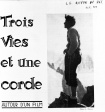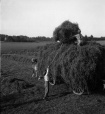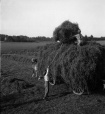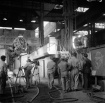Les Maisons de Misère
| 片名: | Les Maisons de Misère |
|---|---|
| 其它片名: | 苦难之家/Houses of Misery |
| 导演: | Henri Storck, Fernand Piette |
| 编剧: | Henri Storck, Fernand Piette |
| 制片人: | R.G. Le Vaux, Dassonville Laboratory, Gevaert film |
| 摄影: | Eli Lotar, John Ferno |
| 剪辑: | Henri Storck |
| 主演: | Brenda, Beauffre, Marion Chevolet, Gazeau, Jihem |
| 音乐: | Maurice Jaubert |
| 片长: | 30分钟 |
| 年份: | 1937年 |
| 类型: | 纪录片 |
| 国别: | 比利时 |
| 语言: | 法语 |
| 格式: | 35毫米/黑白 |
| 制作机构: | National society for low-price housing |
影片概述 . . . . . .
This fictional documentary begins and ends with a chorus and a song
that has the emotional impact of "The Damned of the Earth" or "The
Threepenny Opera". Borinage left Henri Storck profoundly disturbed by
injustice and social poverty. When he was offered a chance to make
another such film he undertook an in-depth survey into the working
class and slums and shouldered once again his camera as a militant
filmmaker. In a plot of Walloon slums he staged characters and
situations as examples: the promiscuity of large families, women who
die in childbirth, the fear of the bailiffs, the money lenders and the
heartless, grasping landlords, the evictions, the children deprived of
childhood, the unemployment, the incest and the sluts, the
tuberculosis, the impossibility of learning, the solidarity between
neighbours. All shots work on intensity, the filling of the frame,
which gives the impression of being unable to breathe, of being
trapped, closed in. For example: the tiny room where a whole family
sleeps piled up in such a way as to make it impossible to move around
without stepping over a body or moving a basin; the children's
cemetery; the portrait of a family under a clothes line on which is
hanging a mixed bunch of socks with holes in them; the stealing of the
scooter, the six-year old kids transformed into little mums for the
last-born child. And in the face of this overflowing misery is the
emptiness of the expressions, the absence of emotion. Survival is all.
But the message of hope is there, with the destruction of slums (the
hovels are demolished as if getting rid of a tyrant) and the
construction of garden cities surrounded by trees in bloom and a future
of song, leaves one with the impression that man's dignity has been
safeguarded.
"Over half of these three reels paint a violent, devastating picture of
the horror of the slums such as I have never seen created in the
cinema. Nothing in the American films on similar subjects comes close
to the intelligence, the sensitivity and the generosity that the author
of this film brought to his task."
Paul Strand, The American Filmmaker, 1939
"The subject matter has been fictionalized; it was played by seventy
actors and extras. It was chosen by the Museum of Modern Art in New
York as one of the best documentaries produced in the world, and in
Belgium it was awarded the highest distinction, the Grand Prix du Roi."
Press release of the CEP
这部故事纪录片的开篇和结尾笼罩于《受诅的地球》或《三毛钱歌剧》此等歌曲的感性情调之中。由于深受不公和贫困的困扰,Henri storck最终选择离开Borinage。当得到机会拍摄另一部纪录片时,他决定像一名激进分子那样,扛起摄像机,深入到工人阶级和贫民区中去。例如在瓦隆贫民区的场景中,人们便看到这样一幅幅画面:混乱杂居的家庭,死于难产的母亲,对法警的恐慌,无情的放债人,贪婪的房东,流离失所的人们,孩子们过着贫瘠的童年,人们失去工作,荡妇和乱伦之祸随处可见,饱受疾病折磨的人,不可能完成的学业,以及邻里之间的团结。
镜头中充斥着强烈的感情色彩。而画面的饱满度给人一种难以呼吸,深陷其中的感受。例如:所有家庭成员挤睡在一间窄小的房间中,除非跨越人体或挪动什物,否则根本不可能在房间中走动;孩子们的墓地;一副全家福,照片中的人们全部衣衫褴褛;盗窃脚踏车;为了照顾刚出生的婴儿,六岁的孩子摇身一变成为母亲。
面对如此沉重的苦难,人们却面无表情,没有任何情感的表露。生存就是一切。而希望正在传达着信息,如同推翻一个暴君的统治,人们将贫民区夷为平地,开始建造一个绿树成荫,鲜花盛开的花园城市,而歌声中所展示的的未来,则将留给人们这样的印象:人的尊严终将受到捍卫 。
"这三份卷轴的一半以上都在为贫民区刻画出一种强烈的,毁灭性的恐惧气氛,这是我在电影院从没看到过的。而这部电影中,作者赋予他的作品的智慧,敏感,以及慷慨,还从没有一部同类题材的美国电影能够做到。
Paul Strand,美国电影制片人,1939年
"这样一个主题被赋予故事情节,并由70名主要和临时演员呈现出来。作为世界上最优秀的纪录片之一,这部电影被美国现代艺术博物馆收藏。在比利时,它则被赋予了最高荣誉,<国王大奖>。"
CEP媒体通稿
that has the emotional impact of "The Damned of the Earth" or "The
Threepenny Opera". Borinage left Henri Storck profoundly disturbed by
injustice and social poverty. When he was offered a chance to make
another such film he undertook an in-depth survey into the working
class and slums and shouldered once again his camera as a militant
filmmaker. In a plot of Walloon slums he staged characters and
situations as examples: the promiscuity of large families, women who
die in childbirth, the fear of the bailiffs, the money lenders and the
heartless, grasping landlords, the evictions, the children deprived of
childhood, the unemployment, the incest and the sluts, the
tuberculosis, the impossibility of learning, the solidarity between
neighbours. All shots work on intensity, the filling of the frame,
which gives the impression of being unable to breathe, of being
trapped, closed in. For example: the tiny room where a whole family
sleeps piled up in such a way as to make it impossible to move around
without stepping over a body or moving a basin; the children's
cemetery; the portrait of a family under a clothes line on which is
hanging a mixed bunch of socks with holes in them; the stealing of the
scooter, the six-year old kids transformed into little mums for the
last-born child. And in the face of this overflowing misery is the
emptiness of the expressions, the absence of emotion. Survival is all.
But the message of hope is there, with the destruction of slums (the
hovels are demolished as if getting rid of a tyrant) and the
construction of garden cities surrounded by trees in bloom and a future
of song, leaves one with the impression that man's dignity has been
safeguarded.
"Over half of these three reels paint a violent, devastating picture of
the horror of the slums such as I have never seen created in the
cinema. Nothing in the American films on similar subjects comes close
to the intelligence, the sensitivity and the generosity that the author
of this film brought to his task."
Paul Strand, The American Filmmaker, 1939
"The subject matter has been fictionalized; it was played by seventy
actors and extras. It was chosen by the Museum of Modern Art in New
York as one of the best documentaries produced in the world, and in
Belgium it was awarded the highest distinction, the Grand Prix du Roi."
Press release of the CEP
这部故事纪录片的开篇和结尾笼罩于《受诅的地球》或《三毛钱歌剧》此等歌曲的感性情调之中。由于深受不公和贫困的困扰,Henri storck最终选择离开Borinage。当得到机会拍摄另一部纪录片时,他决定像一名激进分子那样,扛起摄像机,深入到工人阶级和贫民区中去。例如在瓦隆贫民区的场景中,人们便看到这样一幅幅画面:混乱杂居的家庭,死于难产的母亲,对法警的恐慌,无情的放债人,贪婪的房东,流离失所的人们,孩子们过着贫瘠的童年,人们失去工作,荡妇和乱伦之祸随处可见,饱受疾病折磨的人,不可能完成的学业,以及邻里之间的团结。
镜头中充斥着强烈的感情色彩。而画面的饱满度给人一种难以呼吸,深陷其中的感受。例如:所有家庭成员挤睡在一间窄小的房间中,除非跨越人体或挪动什物,否则根本不可能在房间中走动;孩子们的墓地;一副全家福,照片中的人们全部衣衫褴褛;盗窃脚踏车;为了照顾刚出生的婴儿,六岁的孩子摇身一变成为母亲。
面对如此沉重的苦难,人们却面无表情,没有任何情感的表露。生存就是一切。而希望正在传达着信息,如同推翻一个暴君的统治,人们将贫民区夷为平地,开始建造一个绿树成荫,鲜花盛开的花园城市,而歌声中所展示的的未来,则将留给人们这样的印象:人的尊严终将受到捍卫 。
"这三份卷轴的一半以上都在为贫民区刻画出一种强烈的,毁灭性的恐惧气氛,这是我在电影院从没看到过的。而这部电影中,作者赋予他的作品的智慧,敏感,以及慷慨,还从没有一部同类题材的美国电影能够做到。
Paul Strand,美国电影制片人,1939年
"这样一个主题被赋予故事情节,并由70名主要和临时演员呈现出来。作为世界上最优秀的纪录片之一,这部电影被美国现代艺术博物馆收藏。在比利时,它则被赋予了最高荣誉,<国王大奖>。"
CEP媒体通稿
导演阐述 . . . . . .
首先,这部电影需要成为一份无可指责的,引人注意的调查报告。因此我们将它拍成一部纪录片。然而,一方面,我们希望避免叙述者的干涉,另一方面,我们希望在这个贫民区中的的住户们自己讲述他们自己的故事,在观众面前演绎他们平凡的日常生活。因此,我们构造了一系列看似关联松散,逻辑上却丝丝入扣的情节,从而形成了这样一份报告。
这部电影的性质,使得如此一份真实完整的报告得以展现在屏幕上。而随着一系列情节的展开,这部电影在这样一个特定时期下的戏剧性面貌和形式才得以实现。在我看来,将故事片纪录片以这种方式如此紧密的融合在一起,不仅是可行的,更是值得的。我相信,这种欠明朗的形式,给未来提供了很大的可能性。
Henri Storck,访谈于1937年
"Above all, the film needed to have the character of an inquiry, of
irreproachable and captivating reporting. So we made it into a pure
documentary. However, the desire on the one hand to avoid the
intervention of a presenter, and on the other, to make the inhabitants
of the slums speak about the slums and allow them to live out ordinary
episodes of their everyday lives before the spectators, led us to
create a series of scenes connected to each other by a loose anecdotal
link, but also by a link of logical and precise reporting. The formula
of the film allows a genuine and constructed report to unfold on the
screen and, with the aid of a series of acted scenes, gives the film a
dramatic aspect and form at certain times. I think it is possible and
even rewarding to closely mix drama and documentary in this way. I
believe that this formula, as yet ill-defined, offers great
possibilities for the future.
Henri Storck, interview, 1937
这部电影的性质,使得如此一份真实完整的报告得以展现在屏幕上。而随着一系列情节的展开,这部电影在这样一个特定时期下的戏剧性面貌和形式才得以实现。在我看来,将故事片纪录片以这种方式如此紧密的融合在一起,不仅是可行的,更是值得的。我相信,这种欠明朗的形式,给未来提供了很大的可能性。
Henri Storck,访谈于1937年
"Above all, the film needed to have the character of an inquiry, of
irreproachable and captivating reporting. So we made it into a pure
documentary. However, the desire on the one hand to avoid the
intervention of a presenter, and on the other, to make the inhabitants
of the slums speak about the slums and allow them to live out ordinary
episodes of their everyday lives before the spectators, led us to
create a series of scenes connected to each other by a loose anecdotal
link, but also by a link of logical and precise reporting. The formula
of the film allows a genuine and constructed report to unfold on the
screen and, with the aid of a series of acted scenes, gives the film a
dramatic aspect and form at certain times. I think it is possible and
even rewarding to closely mix drama and documentary in this way. I
believe that this formula, as yet ill-defined, offers great
possibilities for the future.
Henri Storck, interview, 1937
获得奖项 . . . . . .
评论列表(0) . . . . . . ( 发表新评论 ) ( 更多评论 )
幕后花絮 . . . . . . (上传花絮) (展开所有)
影片图集 . . . . . . (更多/我要上传)
相关视频 . . . . . . (更多/我要分享)
对本影片资料作出贡献的会员 . . . . . .
4444(创建者)
Henri Storck导演的其它影片 . . . . . .
相关资讯 . . . . . .
- CDFF2009 DAY2:亨利斯托克回顾展映后交流实录 2009-05-26
- CDFF2009 DAY2 亨利·斯托克回顾展--研讨会现场 2009-05-25
- CDFF2009将举办亨利·斯托克回顾展 2009-05-15
















